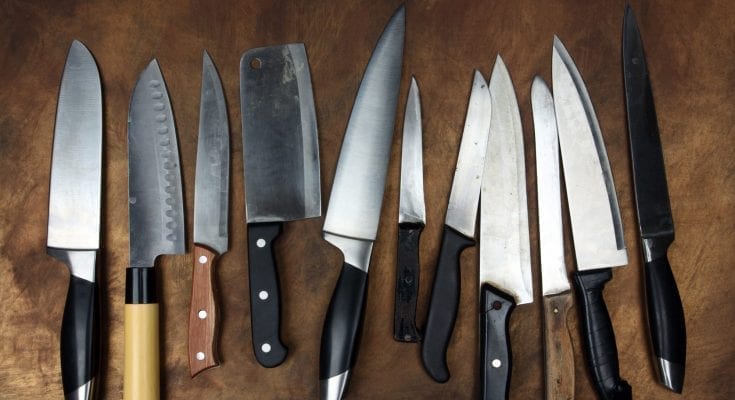Knives are around 2.6 million years old if we’re counting any sharp-edged tool used by our ancestors. This makes them much older than us, the Homo Sapiens.
Such tools aren’t that refined, considering they’re made of stones cracked to make sharp edges. Still, they were useful in hunting, fishing, and defending from predators.
Today, our knives are much more polished, but their purposes remain the same for the most part. Having been in history and prehistory for quite some time, this type of tool has accumulated its fair share of interesting facts.
Want to learn all about knives? Check out 11 of the most interesting facts about them below.
1. The World’s Most Expensive Knife
The most expensive knife in the world isn’t something you can save up for. That is unless you can save $2.1 million in your lifetime. It didn’t belong to any king or royalty whatsoever; it was a stand-alone project of Buster Warenski, who was a custom knifemaker from Kimberley, Nevada.
Warenski was all about knives with art. He created the Gem of the Orient as the second knife in his Legacy Series.
It took him 10 years to finish this beauty. It incorporated 153 emeralds with 10 total karats and 9 diamonds with 5 total karats.
2. What Kind of Knife Belongs to Royalty?
What belonged to a previous king is a meteor knife found in King Tutankhamun’s burial chamber. It was one of the two knives found around his body in 1925, with the other being gold.
The iron blade, and not the gold knife, was what intrigued the archeologists, though. That’s because iron smelting wasn’t so common at that period.
They already suspected it was from a meteorite, but that take was controversial at the time. It was only in 2016 when researchers had conclusive evidence it was extraterrestrial in origin.
3. Obsidian Knives are Better for Surgery, Though
The most expensive knife isn’t necessarily the sharpest knife around. The title goes to obsidian knives, but even that is debatable depending on what you can consider a knife.
Obsidian blades cut so fine that they’re used for surgeries requiring precision. On a cellular level, they cut between cells rather than tear the cells, which steel knives are guilty of.
When obsidian breaks, they have the cleanest edge that’s about one molecule thick.
4. Can You Kill 80 Bears with a Knife?
You most likely can’t, but one person in history allegedly can. Teddy Roosevelt, in his book “The Wilderness Man,” named Confederate Cavalry Leader Wade Hampton III as someone who killed 80 bears with only a knife.
What he would usually do was to corner the bear and provoke it to charge. He would then dart to the side before stabbing it in the heart.
5. Why is a Penknife Called a Penknife?
Have you ever wondered why you call a small folding knife a penknife? You might think that it’s because they’re almost the same size as a pen, but you’re wrong.
It gets its name from its purpose centuries ago. People used it to sharpen their quill to make a pen nib.
Of course, it wasn’t a folding knife back then, but the name stuck.
6. One Tool in a Swiss Knife is Not From Switzerland
A Swiss knife has 33 different tools, and Switzerland manufactures all of then save one. The exception is the corkscrew tool, which comes from Japan instead.
7. All About Knives in Japan
Japanese knives are highly-sought out because of their quality. One factor contributing to its popularity is that it has deep roots in tradition.
They use hagane, a type of carbon steel that can hold an extremely sharp edge. They can stay sharp for a longer time than Western knives. Because of its characteristics, it’s the same kind used in samurai swords.
The creation of a Japanese kitchen knife also often includes traditional blacksmithing techniques. Aside from kitchen knives, though, the Japanese also have other cool knives, like the Hori Hori knife.
8. Use a Sharp Knife to Cut Onions
A Japanese knife is an awesome knife for this because the sharper the knife is, the lesser the chances of you crying.
Damaging the cell walls cause the onion to release syn-propanethial-S-oxide, which is the irritant that makes you tear up. Sharp knives cause less damage to the onion’s cell walls, making for a “no tears” formula.
9. A Knife for Ending a Knight’s Misery
There’s a knife with a sole, grim purpose: to finish off knights with mortal wounds, which didn’t always mean a quick death.
It has quite a fitting name for a knife that delivers the death blow to a suffering companion. It’s called miséricorde, which is a French word for mercy. The word also has Latin roots; misericordia is Latin for “act of mercy.”
It was in use during the High Middle Ages. The wielder pushes it through the holes in the helm or armor to pierce the brain or heart.
10. A Knife to Cool You Down on the Inside
Not all knives are for mercy killing, though. This one aims to deal great damage to bring down a healthy (but might be aggressive) animal real quick.
It’s the Injector Knife by WASP, which injects compressed gas into a victim when stabbed. It releases the gas at 850psi of pressure, creating a basketball-sized air pocket inside. It also freezes the surrounding organs in an instant.
11. French Gangsters Were a Little Too Creative
The 1900s were a bad time to get involved with French gangsters because of the Apache revolver. In a technical sense, it’s a handgun, but it has other uses. It also has a knife and its handles are brass knuckles.
For these reasons, it had high efficiency in close combat.
Discover More Cool Facts Today!
Do you like hearing all about knives? Us, too; they’re not the boring kitchen utensils most people think they are.
If you want to learn more fascinating facts like this, feel free to read more from our blog posts today. We cover a lot of strange and amazing facts, so don’t hesitate to check out other lists right here, today!



